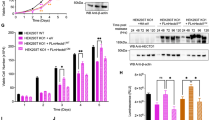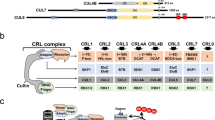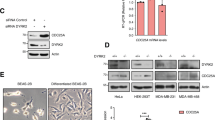Abstract
The cyclin-dependent kinase inhibitor p27Kip1 is degraded at the G0–G1 transition of the cell cycle by the ubiquitin–proteasome pathway1,2. Although the nuclear ubiquitin ligase (E3) SCFSkp2 is implicated in p27Kip1 degradation3,4,5,6, proteolysis of p27Kip1 at the G0–G1 transition proceeds normally in Skp2−/− cells7,8. Moreover, p27Kip1 is exported from the nucleus to the cytoplasm at G0–G1 (refs 9–11). These data suggest the existence of a Skp2-independent pathway for the degradation of p27Kip1 at G1 phase. We now describe a previously unidentified E3 complex: KPC (Kip1 ubiquitination-promoting complex), consisting of KPC1 and KPC2. KPC1 contains a RING-finger domain, and KPC2 contains a ubiquitin-like domain and two ubiquitin-associated domains. KPC interacts with and ubiquitinates p27Kip1 and is localized to the cytoplasm. Overexpression of KPC promoted the degradation of p27Kip1, whereas a dominant-negative mutant of KPC1 delayed p27Kip1 degradation. The nuclear export of p27Kip1 by CRM1 seems to be necessary for KPC-mediated proteolysis. Depletion of KPC1 by RNA interference also inhibited p27Kip1 degradation. KPC thus probably controls degradation of p27Kip1 in G1 phase after export of the latter from the nucleus.
This is a preview of subscription content, access via your institution
Access options
Subscribe to this journal
Receive 12 print issues and online access
$209.00 per year
only $17.42 per issue
Buy this article
- Purchase on Springer Link
- Instant access to full article PDF
Prices may be subject to local taxes which are calculated during checkout





Similar content being viewed by others
References
Pagano, M. et al. Role of the ubiquitin–proteasome pathway in regulating abundance of the cyclin-dependent kinase inhibitor p27. Science 269, 682–685 (1995).
Shirane, M. et al. Down-regulation of p27Kip1 by two mechanisms, ubiquitin-mediated degradation and proteolytic processing. J. Biol. Chem. 274, 13886–13893 (1999).
Carrano, A. C., Eytan, E., Hershko, A. & Pagano, M. SKP2 is required for ubiquitin-mediated degradation of the CDK inhibitor p27. Nature Cell Biol. 1, 193–199 (1999).
Sutterluty, H. et al. p45SKP2 promotes p27Kip1 degradation and induces S phase in quiescent cells. Nature Cell Biol. 1, 207–214 (1999).
Tsvetkov, L. M., Yeh, K. H., Lee, S. J., Sun, H. & Zhang, H. p27Kip1 ubiquitination and degradation is regulated by the SCFSkp2 complex through phosphorylated Thr187 in p27. Curr. Biol. 9, 661–664 (1999).
Nakayama, K. et al. Targeted disruption of Skp2 results in accumulation of cyclin E and p27Kip1, polyploidy and centrosome overduplication. EMBO J. 19, 2069–2081 (2000).
Hara, T. et al. Degradation of p27Kip1 at the G0-G1 transition mediated by a Skp2-independent ubiquitination pathway. J. Biol. Chem. 276, 48937–48943 (2001).
Nakayama, K. et al. Skp2-mediated degradation of p27 regulates progression into mitosis. Dev. Cell 6, 661–672 (2004).
Ishida, N. et al. Phosphorylation of p27Kip1 on serine 10 is required for its binding to CRM1 and nuclear export. J. Biol. Chem. 277, 14355–14358 (2002).
Tomoda, K., Kubota, Y. & Kato, J. Degradation of the cyclin-dependent-kinase inhibitor p27Kip1 is instigated by Jab1. Nature 398, 160–165 (1999).
Rodier, G. et al. p27 cytoplasmic localization is regulated by phosphorylation on Ser10 and is not a prerequisite for its proteolysis. EMBO J. 20, 6672–6682 (2001).
Li, C., Rodriguez, M., Adamson, J. W. & Banerjee, D. Identification of a glialblastoma cell differentiation factor-related gene mRNA in human microvascular endothelial cells. Genomics 65, 243–252 (2000).
Ponting, C., Schultz, J. & Bork, P. SPRY domains in ryanodine receptors (Ca2+-release channels). Trends Biochem. Sci. 22, 193–194 (1997).
Wilkinson, C. R. et al. Proteins containing the UBA domain are able to bind to multi-ubiquitin chains. Nature Cell Biol. 3, 939–943 (2001).
Chen, L., Shinde, U., Ortolan, T. G. & Madura, K. Ubiquitin-associated (UBA) domains in Rad23 bind ubiquitin and promote inhibition of multi-ubiquitin chain assembly. EMBO Rep. 2, 933–938 (2001).
Yoshida, M. & Horinouchi, S. Trichostatin and leptomycin. Inhibition of histone deacetylation and signal-dependent nuclear export. Ann. NY Acad. Sci. 886, 23–36 (1999).
Liang, J. et al. PKB/Akt phosphorylates p27, impairs nuclear import of p27 and opposes p27-mediated G1 arrest. Nature Med. 8, 1153–1160 (2002).
Viglietto, G. et al. Cytoplasmic relocalization and inhibition of the cyclin-dependent kinase inhibitor p27Kip1 by PKB/Akt-mediated phosphorylation in breast cancer. Nature Med. 8, 1136–1144 (2002).
Shin, I. et al. PKB/Akt mediates cell-cycle progression by phosphorylation of p27Kip1 at threonine 157 and modulation of its cellular localization. Nature Med. 8, 1145–1152 (2002).
Bornstein, G. et al. Role of the SCFSkp2 ubiquitin ligase in the degradation of p21Cip1 in S phase. J. Biol. Chem. 278, 25752–25757 (2003).
Kamura, T. et al. Degradation of p57Kip2 mediated by SCFSkp2-dependent ubiquitination. Proc. Natl Acad. Sci. USA 100, 10231–10236 (2003).
Hershko, A., Heller, H., Elias, S. & Ciechanover, A. Components of ubiquitin-protein ligase system. Resolution, affinity purification, and role in protein breakdown. J. Biol. Chem. 258, 8206–8214 (1983).
Kamura, T. et al. The Elongin BC complex interacts with the conserved SOCS-box motif present in members of the SOCS, ras, WD-40 repeat, and ankyrin repeat families. Genes Dev. 12, 3872–3881 (1998).
Kamura, T. et al. Rbx1, a component of the VHL tumor suppressor complex and SCF ubiquitin ligase. Science 284, 657–661 (1999).
Morita, S., Kojima, T. & Kitamura, T. Plat-E: an efficient and stable system for transient packaging of retroviruses. Gene Ther. 7, 1063–1066 (2000).
Nakayama, K. et al. Mice lacking p27Kip1 display increased body size, multiple organ hyperplasia, retinal dysplasia, and pituitary tumors. Cell 85, 707–720 (1996).
Acknowledgements
We thank T. Kitamura for pMX-puro; R. Yada, N. Nishimura and S. Matsushita for technical assistance; and M. Kimura, A. Ohta and C. Sugita for help in preparation of the manuscript. This work was supported in part by a grant from the Ministry of Education, Science, Sports and Culture of Japan, and by a research grant from the Human Frontier Science Program.
Author information
Authors and Affiliations
Corresponding author
Ethics declarations
Competing interests
The authors declare no competing financial interests.
Supplementary information
Supplementary Information
Fig. S1, S2, S3 and S4 (PDF 278 kb)
Rights and permissions
About this article
Cite this article
Kamura, T., Hara, T., Matsumoto, M. et al. Cytoplasmic ubiquitin ligase KPC regulates proteolysis of p27Kip1 at G1 phase. Nat Cell Biol 6, 1229–1235 (2004). https://doi.org/10.1038/ncb1194
Received:
Accepted:
Published:
Issue Date:
DOI: https://doi.org/10.1038/ncb1194
This article is cited by
-
FOXO transcription factors as mediators of stress adaptation
Nature Reviews Molecular Cell Biology (2024)
-
The NF-ĸB p50 subunit generated by KPC1-mediated ubiquitination and limited proteasomal processing, suppresses tumor growth
Cancer Cell International (2023)
-
The A-to-I editing of KPC1 promotes intrahepatic cholangiocarcinoma by attenuating proteasomal processing of NF-κB1 p105 to p50
Journal of Experimental & Clinical Cancer Research (2022)
-
ACK1 upregulated the proliferation of head and neck squamous cell carcinoma cells by promoting p27 phosphorylation and degradation
Journal of Cell Communication and Signaling (2022)
-
ZSWIM8 is a myogenic protein that partly prevents C2C12 differentiation
Scientific Reports (2021)



